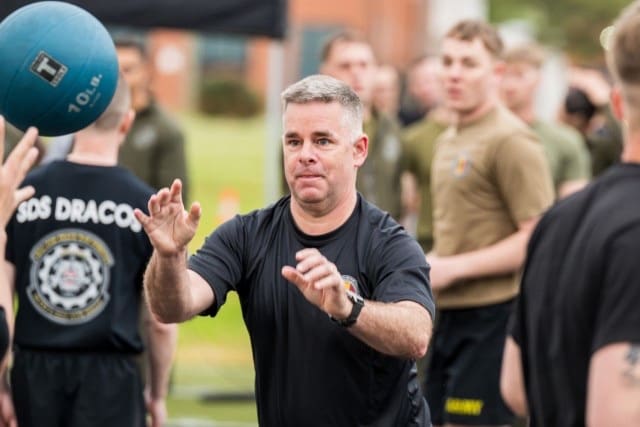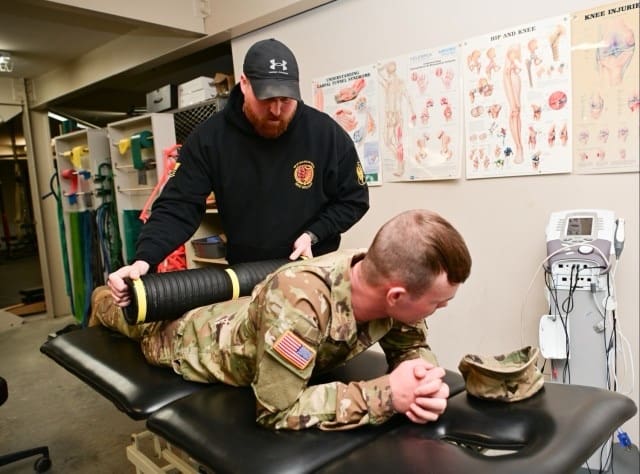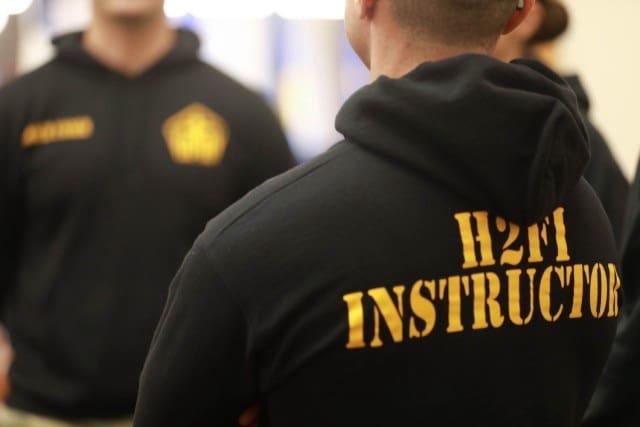Warfighting is at the forefront of everything we do in the Army, and over the past five years, the culture of human performance has evolved to ensure that Soldiers are prepared to fight and win our nation’s wars.
Holistic Health and Fitness (H2F) has transformed the way soldiers train for future battles. It has shifted away from a one-size-fits-all model for human performance to a more individualized approach, tailored to preparing Soldiers to win on the modern battlefield and return home healthy. This revolutionary shift is supported by teams of subject matter experts, embedded within the Brigade footprint, that work directly for the Brigade Commander to meet the specific units’ Mission Essential Task List (METL).

“In a fiscally restrained time, leaders within the Department of War recognize the direct, proven, and significant impact our H2F teams have on our Soldiers’ warfighting ability and as a result have excluded the H2F civilian professionals from the civilian hiring freeze, supported rapidly expansion of the program, and the procurement of the first human performance optimization platform across the Department”, said Lt. Gen. David Francis, Commander, U.S. Army Center for Initial Military Training, the Army’s proponent for H2F. “The H2F System has the full support and backing of both the Secretary of War and the Secretary of the Army as we have worked directly to inform them on the positive return on investment data that our H2F teams are having on our warfighting abilities”.
Initially planned and resourced for 111 Active Duty Brigades, Army Senior Leaders announced after reviewing the initial Return on Investment (ROI) data that H2F Performance Teams (HPTs) would be resourced to every unit across the Army.
ROI data indicates that, although it comes with an initial heavy price tag, H2F is paying for itself year over year by getting our warfighters back into the fight, both fitter and faster. Data currently being peer-reviewed indicates that for every dollar spent on H2F, $8.15 in cost avoidance and readiness gains are realized. The United States Army Research Institute of Environmental Medicine (USARIEM) also conducted independent research, consisting of over 30 million Soldier observations from Fiscal Year 2019-2024, and found that if H2F HPTs were rolled out Army-wide, it would have added 1,080 deployable Soldiers to the fighting force. These 1,080 Soldiers equate to adding over ten company sized elements of combat power back into the fight.
“The Army is rapidly transforming to ensure our Soldiers are prepared to fight and win our nation’s wars”, said Col. John “Jay” Morgan, H2F Director. “Through the H2F HPTs, across our Army, we are equipping our warfighters with human performance subject matter experts who ensure, when called, our Soldiers are prepared to fight, win, and dominate on the modern battlefield”.
By Fiscal Year 2029, the Army will have fielded 129 Active-Duty Brigades, four states throughout the Army National Guard, and two Army Reserve Commands will be equipped with HPTs. A key distinction between how the Active Duty and Reserve Component HPTs will operate, due to their distinct differences, is the level of support they will provide. Reserve Component HPTs will work directly for their Adjutant General or major Army Reserve Command, rather than a Brigade Commander, to meet their units’ METL and resolve unique challenges these Soldiers face, balancing their civilian and military careers that Active-Duty units do not face. To support geo-dispersed and smaller Brigade sized elements 59 H2F Area Support Teams (H2FAST) will be fielded and directly work for their Installation Senior Mission Commander.
“H2F is a Commanders program, Commanders need to know these HPTs work for them”, said Gen. James Mingus, Vice Chief of Staff of the Army. “These HPTs are filled with subject matter experts who treat our warfighters like professional athletes. Having this level of expertise within these teams, like what Division 1 schools have, helps the Command team best prepare Soldiers for combat”.

Throughout the rapid expansion process, the Army has navigated a challenging hiring environment. The Secretary of War, Honorable Pete Hegseth, exempted all H2F positions from the civilian hiring freeze to ensure only the best and brightest physical and occupational therapists and registered dietitians were on board our HPTs. Further, in September of this year, based on strong positive feedback from commanders, the Vice Chief of Staff of the Army approved a change to the composition of the H2F Performance Teams (HPT) and H2F Area Support Teams (H2FAST) to include 4 Athletic Trainers (AT) per team through FY29.
To streamline the expansion of H2F expertise across the force, the Army has collaborated directly with the Department of War to develop the requirements for fielding the first human performance optimization platform across the Department. This software solution, designed for the Army, is called the H2F Management System (H2FMS) and serves as the software backbone of the H2F System, providing Soldiers, leaders, and HPT staff with data-driven insights that are typically only found within Special Operations or professional athletics.
“H2FMS will empower HPTs across the Total Army to effectively measure, analyze, and improve Soldier performance and overall combat readiness”, said Lt. Col. Chance Smith, Operations Research and Systems Analyst, U.S. Army Center for Initial Military Training. “Our partners at Program Executive Office- Soldier have provided valuable insights into building out requirements, streamlining the procurement process, and ensuring that H2FMS is designed to impact the warfighter positively”.
Soldier Performance Readiness Centers, or SPRCs, are the home to H2F human performance teams that deliver comprehensive, immersive, and integrative training experiences for soldiers. In partnership with the U.S. Army Corps of Engineers, Installation Management Command (IMCOM), and the Assistant Secretary of the Army for Installations, Energy and Environment (IE&E) Army Senior Leaders approved plans to improve 67 facilities this fiscal year and to complete four designs for SPRC Experiment (SPRC-X), which utilize unconventional construction where new construction is needed.
Paramount to the Army’s investments across the H2F System in people, facilties, data management, and equipment is the buy-in from operational non-commissioned officers (NCOs) who have an enduring and foundational role in unit training. The Army recently concluded the first pilot of the new Skills Qualification Identifier (SQI) for the H2F Advisor. This SQI, only eligible for NCOs, is the Army’s latest investment in empowering the NCO Corps to serve as the “Master Gunner” for human performance on a Brigade or Battalion staff.

“The H2F Advisor SQI empowers the NCO Corps to directly advise Commanders on the ways best to incorporate human performance-oriented, battle-focused training into their units’ long-term training calendar”, said Sgt. Maj. Jeremiah Richards, H2F Senior Enlisted Advisor. “H2F Advisors serve as the bridge between the HPTs and the H2F Integrators below the Brigade level to synchronize H2F implementation throughout”.
As the Army expands H2F across the force, it has also expanded its scope of responsibilities to include functional proponency for the Pregnancy and Postpartum Performance Training (P3T) program. Formerly known as Pregnancy and Postpartum Physical Training, the P3T team is rapidly reviewing and revising educational content and training P3T leaders to implement effective physical training and education to support perinatal Soldiers return to the operational force fitter. By incorporating the most current evidence across the five domains of readiness, the revised P3T program is seeing similar ROI as the H2F System.

In a recent U.S. Army Center for Initial Military Training questionnaire, 75% of respondents indicated that participating in a unit-run P3T course improved their Army Fitness Test (AFT) score. Preliminary data demonstrates that soldiers who participated in P3T saw an average increase of 50 points in AFT scores before returning to their units.
“Roughly 10,000 Soldiers across the total Army give birth to a child every year”, said Maj. Stephanie Meno, H2F Nutrition and P3T lead. “The most profound shift in the P3T program is the inclusion of all give domains of H2F, pelvic-health education, and the most current evidence for maintaining optimal health and fitness in a perinatal population. Soldiers who participate in P3T throughout pregnancy and postpartum are returning to their formations fitter, faster, and stronger than before becoming pregnant”.
H2F will be hosting their annual Symposium, from 13-14 May, where the Directorate announces ROI metrics for the currently fielded H2F teams, have Army Senior Leaders speak on the program, and highlight the best HPTs across the Total Army.
Register for the Symposium at: www.militaryexpos.com/h2f
By Hunter Rhoades, U.S. Army Center for Initial Military Training


































































































































